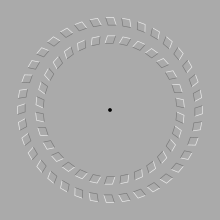Optical illusion





An optical illusion (also called a visual illusion) is one which shows images that differ from normal reality.
The information gathered by the eye is processed in the brain to give a perception. That is normal, but in these cases the appearance does not tally with a physical measurement of the stimulus source.
There are three main types of visual illusion:
- literal optical illusions that create images which are different from the objects that make them
- physiological illusions: they are the effects on the eyes and brain of over-stimulation of brightness, colour, size, position, tilt, movement
- cognitive illusions, the result of unconscious inferences (brain makes the wrong decision).
The general explanation for most illusions is the way the brain works on sense data to produce a meaningful perception. A great 19th century psychologist Hermann von Helmholtz described perception as "unconscious inferences from sensory data and past experience". Richard Gregory discussed how the brain makes an hypothesis about what's out there, and sometimes the hypothesis does not quite work out. His model of perception is an interaction between data from sense organs and previous knowledge and experience.[1][2]
Researcher Mark Changizi of Rensselaer Polytechnic Institute in New York thinks optical illusions are due to a 'neural lag'.[3] When light hits the retina, about one-tenth of a second goes by before the brain translates the signal into a visual perception of the world. Scientists have known of the lag, and have discussed how humans compensate for it. Some suggest that our motor system somehow modifies our movements to offset the delay.
Changizi asserts that the human visual system has evolved to compensate for neural delays by generating images of what will occur one-tenth of a second into the future. This foresight enables humans to react to events in the present, enabling humans to perform reflexive acts like catching a fly ball and to maneuver smoothly through a crowd.[4] Illusions occur when our brains attempt to perceive the future, and those perceptions do not match reality.
Essentially, the ideas of Helmholz, Gregory and Changizi are similar. We do not mechanically turn sense data into a picture of the world, as some had thought. What we do is use our brains to work out what it is we are looking at. This involves the use of memory and logic, though at a fast rate. The process is very good, but not foolproof. When it fails we get an illusion.
References[change | change source]
- ↑ Gregory, Richard 1997. Knowledge in perception and illusion. Phil. Trans. R. Soc. Lond. B 352:1121-1128. (pdf)
- ↑ Gregory R.L. 1970. The intelligent eye. Weidenfeld & Nicolson, London.
- ↑ Changizi, Mark 2009. The vision revolution: how the latest research overturns everything we thought we knew about human vision. Benbella
- ↑ Key to all optical illusions discovered, Jeanna Bryner, Senior Writer, LiveScience.com 6/2/08. His research on this topic is detailed in the May/June 2008 issue of the journal Cognitive Science.
